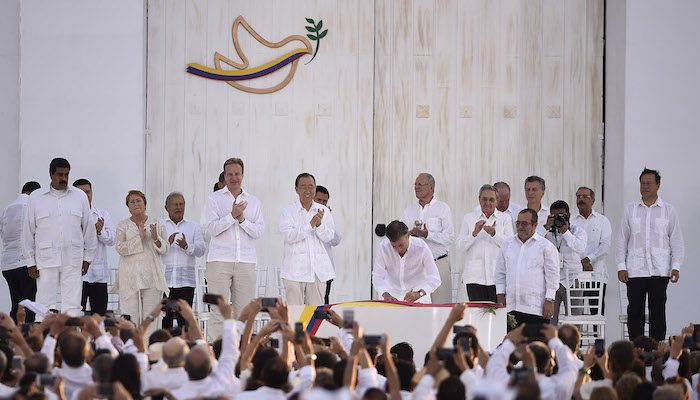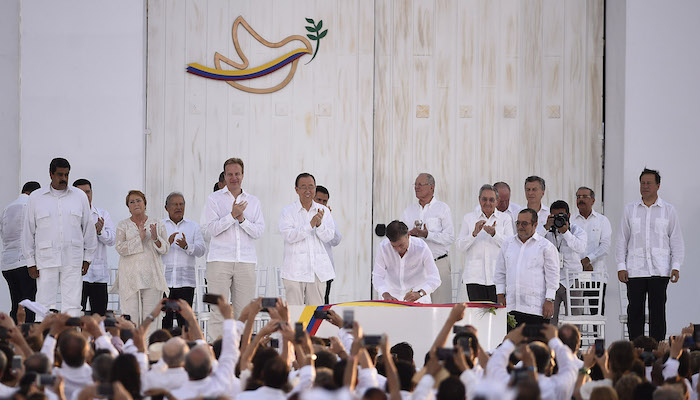
E-IR’s spotlight series invites academics to reflect on significant events, drawing on accessible resources to bring the subject to life for students.
After four years of negotiations the Colombian government led by President Juan Manuel Santos and the Fuerzas Armadas Revolucionarias de Colombia (FARC) finally reached a peace agreement in 2016. While the FARC was not the only guerrilla group active in Colombia, it was the largest one. So this agreement can be considered as a milestone in the way to put an end to the internal armed conflict that has ravaged the country for over 50 years. This was not the first time that the Colombian government had attempted to negotiate peace with the FARC (see here). The administration of Belisario Betancur (1982-1986) had undertaken similar efforts. These resulted in the signing of an agreement that contemplated a bilateral ceasefire, socioeconomic reforms and the entry of the FARC into politics. In 1985 members of the FARC political wing joined like-minded activists and politicians to found the Unión Patriótica (UP) political party. However, the implementation of the agreement slacked off, and some 3000 UP members were killed in what some referred to as a “political genocide”, which led to the collapse of the peace process during the following presidential administration.
Likewise, the government of President Andrés Pastrana (1998-2002) tried to reach an agreement with the FARC, establishing a demilitarized zone of some 42000 km2 to conduct peace talks. Yet, support for the talks gradually eroded, as the war intensified and many people came to see the demilitarized zone as an unacceptable concession to the FARC, which allegedly used it to strengthen its military capacity. The talks also came at the time of the implementation of Plan Colombia, a US aid package mainly aimed at supporting the Colombian government in the combat against drug trafficking and, indirectly, the guerrillas, given their involvement in the drug business. As both parties appeared to be building their military capacity and be only half-heartedly committed to the peace process, it shattered in 2002.
Negotiations under the Santos administration
Exploratory talks with the FARC began shortly after President Santos took office in 2010. Such talks culminated on 26 August 2012 with a general agreement by the government and FARC on a framework to conduct formal peace negotiations, including a six-point agenda: 1. Comprehensive agrarian development policy, 2. Political participation, 3. End of the conflict, 4. Solution to the problem of drug trafficking, 5. Victims, 6. Implementation, verification and endorsement of the peace agreements. This paved the way for the inauguration of formal talks in Oslo, Norway, followed by the beginning of negotiations in Havana, Cuba in November 2012. Two guarantor states, Cuba and Norway, and two accompanying states, Venezuela and Chile, supported the whole process, which ran from 2012 to 2016.
During the process the parties received proposals from the public at large through the Internet, regional consultations, visits by delegations of victims and other groups, etc. The United Nations and the National University of Colombia assisted the parties in the organization of public consultations on the different points of the agenda in various parts of Colombia and the selection of representative victim delegations to provide inputs to negotiators. The centrality of the victims was one of the most acclaimed and novel features of the process (see, for example, here).
Unlike many peace negotiations, the ones conducted under the Santos administration began without bilateral ceasefire. While this made many fear that, should one party seriously hurt the other one, the negotiations would break down, it enabled the parties to engage in dialogue with almost no precondition. The FARC declared several unilateral ceasefires as goodwill gestures, and the government eventually agreed to stop bombing them in a reciprocal move. Only in June 2016 did the parties agree to a bilateral ceasefire. The Agreement on the Bilateral and Definitive Ceasefire and Cessation of Hostilities and Laying down of Arms, signed on 23 June, provided for a tripartite monitoring and verification mechanism, including the participation of the Colombian state, FARC and United Nations. In January 2016 the UN Security Council accepted a request by the Colombian government for UN assistance and unanimously adopted a resolution to establish a special political mission to support the parties in the implementation of the bilateral ceasefire and laying down of arms by former combatants. The mission led by Special Representative of the Secretary-General Jean Arnault has now been deployed and has initiated its monitoring activities as part of the tripartite mechanism.
On 24 August 2016 the parties concluded the negotiations by reaching an agreement on all points of the agenda. They signed it on 26 September in Cartagena, Colombia. The agreement was to be endorsed in a referendum on 2 October to begin implementation, but the electorate rejected the deal by a narrow majority (less than 54000 votes out of 13 million ballots cast). The results were not against peace per se, but against what opponents thought to be excessive concessions to the FARC, which is why most of them campaigned for a renegotiation of the accord. The results also reflected the polarization of society, in particular the rural-urban divide, with victims said to have voted in majority for the agreement, whereas many of those less directly affected by war voted against it.

Renegotiation of the peace accord
Despite this setback, the Santos government and the FARC proved their determination to achieve peace. The government immediately undertook intense consultations with the main promoters of the “no” vote and the FARC, receiving more than 500 proposals, grouped into 57 topics, to amend the agreement. Following further negotiations, the government and the FARC reached a new deal on 12 November, and officially signed the final peace accord in the capital Bogotá on 24 November 2016 (see full text in Spanish here). The new agreement incorporates changes in 56 of the 57 areas where partisans of the “no” had requested modifications (see the declaration by President Santos here). This time the agreement was to be endorsed by Congress, which happened a few days later, marking the beginning of implementation on 1 December.
Importantly, large numbers of people mobilized for peace following the result of the referendum (see, for example, here). Additionally, five days after the result, the Norwegian Nobel committee announced that President Santos was awarded the Nobel peace prize on behalf of the “Colombian people who, despite great hardships and abuses, have not given up hope of a just peace, and to all the parties who have contributed to the peace process”. The committee, in particular, paid tribute to the victims of the war, which had claimed the lives of more than 220 000 people. According to Santos, the announcement was a “gift from heaven”, giving him and the Colombian population the force to move forward in their determination to bring peace to the country. Santos dedicated the prize to the Colombian people, especially to the victims, in the hope that such a conflict never happens again.
What lies ahead?
Peace will not be achieved in Colombia until an agreement is reached with the Ejército de Liberación Nacional (ELN) guerrilla. While the military strength of ELN is more reduced than that of FARC (it only relies on some 2000 fighters in comparison with the approximately 8000 FARC fighters), the ELN exerts control over, and enjoys a strong support base in, important areas (see more about the differences between ELN and FARC here). ELN is also likely to occupy some of the areas left by FARC, as the latter move to assembly sites to begin the disarmament, demobilization and reintegration (DDR) process. On 30 March 2016 the government and ELN signed a framework agreement and announced the beginning of formal peace talks. The agreement included a six-point agenda: 1. Participation of society in peacebuilding, 2. Democracy for peace, 3. Transformations for peace, 4. Victims, 5. End of the armed conflict, 6. Implementation. Formal talks were to start on 3 November. However, because of discrepancies between the two delegations, formal talks on these points have not initiated to date.
Further Reading on E-International Relations
- Student Feature – Spotlight on Kosovo’s “Special Court”
- Student Feature – Spotlight on Qualitative Methods in International Relations
- Student Feature – Spotlight on The United Nations Security Council
- Student Feature – Spotlight on ASEAN
- Student Feature – Spotlight on the International Labour Organization
- Student Feature – Spotlight on the North Atlantic Treaty Organization